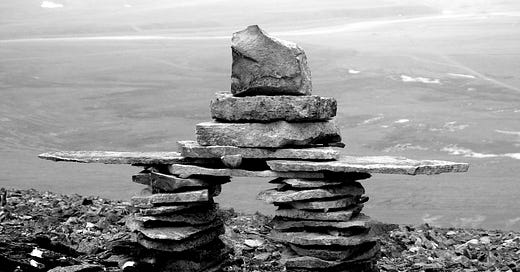Celebrating Indigenous Innovation: The Inuksuk - a True Symbol of Creativity
These structures were around long before colonization; left to mark the way for everyone who came across them
When I think of the Canadian Arctic, I can’t help but picture an Inuksuk (in-OOK-shook)—those quiet stone figures standing tall and enduring, scattered across the tundra, like silent guides and pathfinders.
To the Inuit, they’ve been
vital waypoints,
messengers of survival,
and symbols of community for generations.
In many ways, they represent Indigenous creativity at its best: practical, yet deeply meaningful.
I remember seeing Inuksuit (the plural of Inuksuk) for the first time during a student exchange to Baffin Island back in 1998.
It’s a memory that’s stayed with me, partly because of my exchange partner, Anuga. He often spoke about his desire to live on the land after high school, following the traditional Inuit way of life for “his people.”
True to his word, he did just that.
Every time I see or think about an Inuksuk, I think of him—strong, purposeful, and deeply rooted in the land.
Rock Statues as A Guide to Life in the Arctic
Inuksuit have a history that’s as old as the Arctic itself.
They’re some of the oldest surviving man-made objects in that harsh landscape. Believed to be around at lest 2000 years BC. Their purpose goes beyond the obvious.
These stone structures, crafted from local materials—rounded or flat rocks—can be small or large, depending on their intended use.
Sometimes, they have a window that directs your gaze toward a distant hunting ground,
or they’re shaped to resemble arms and legs, marking a safe passage through the mountains.
There’s even a type with antlers, placed where food was stored for the winter.
Their use as a tool for survival in the Arctic is what stands out to me the most.
In the endless stretch of snow and rock, an Inuksuk could mean the difference between life and death, marking a safe route or warning of danger.
What’s even more powerful, though, is the way these stone figures act as a reminder that we aren’t alone. The Inuit left them to help anyone who came across them—an act of trust and community.
That idea of leaving something behind for the next person, and helping those who come after you, feels very Canadian to me. At least, that is what I want being Canadian to mean.
It’s about caring for each other, even in the simplest ways.
Something we can learn more about from the example set by Inuit people who were here long before colonization.
From the Arctic to Canadian Identity
While the Inuksuk started in the Arctic, its meaning has spread far beyond that landscape.
It’s become a national symbol, appearing everywhere from postcards, to the Vancouver 2010 Winter Olympics. But as familiar as the Inuksuk may be, it’s essential to remember its roots.
For the Inuit, it’s more than a decoration or relic from an ancient past.
It’s a symbol of their ancestors and the knowledge passed down on how to survive, and thrive on the land.
And for non-Inuit people, we must be mindful not to appropriate this important part of Inuit culture.
Did You Know?
Destroying an Inuksuk is illegal, and rightfully so—it’s an offence to the builder, and to the generations who have relied on these markers for survival.
A Personal Reflection on Creativity and Resilience
Standing before an Inuksuk, I’m reminded that creativity can be about art, technology, and survival.
It’s about finding ways to communicate and navigate in a world that can be unpredictable and unforgiving.
The Inuksuk, for all its simplicity, speaks to the ingenuity, strength, and resilience of the Inuit people.
And it’s a reminder for us to look to the past for guidance, while moving forward with respect for those who came before us.
They show us that even in the most barren and challenging places, there’s a deep wisdom to be found, one that connects people to the land and to each other.
In a world that often feels divided, the Inuksuk offers a quiet but powerful lesson: we’re stronger when we leave something behind for others, and when we act as guides for those who come after us.
Did You Know?
The word “Inuksuk” translates to “in the likeness of a human.”
These structures range from small piles of one or two stones to towering figures as tall as a person.
Depending on how the rocks are arranged, an Inuksuk might indicate a safe path, point out a good hunting ground, or mark a sacred place.




